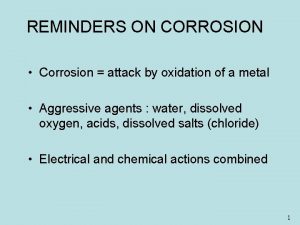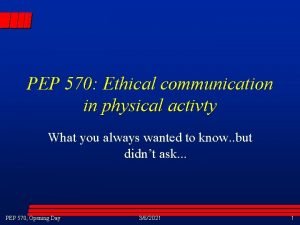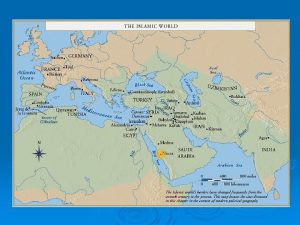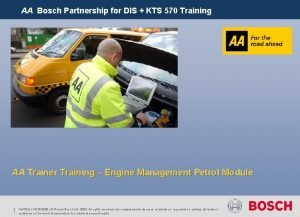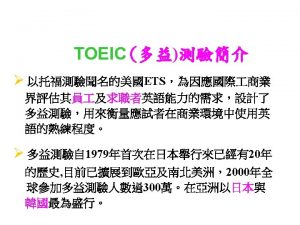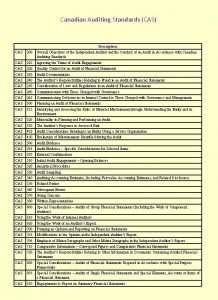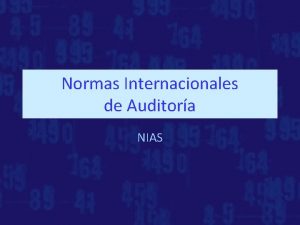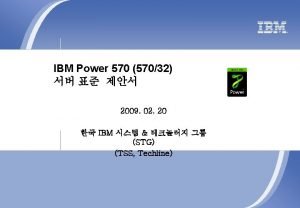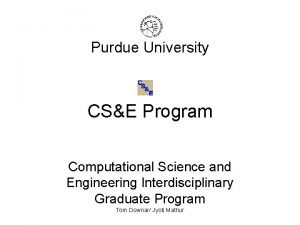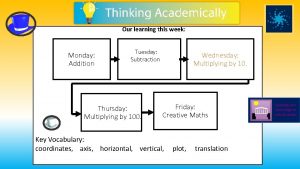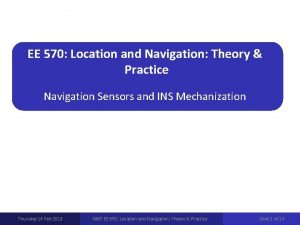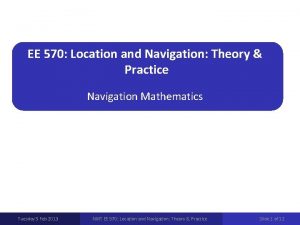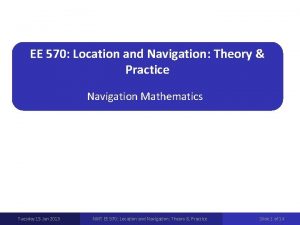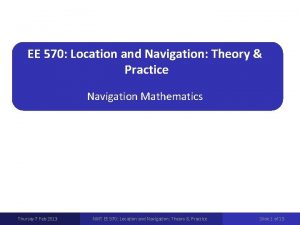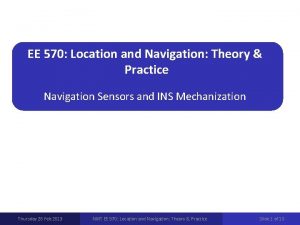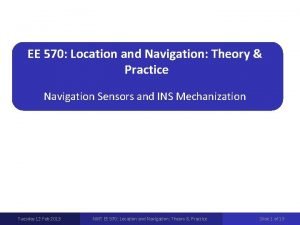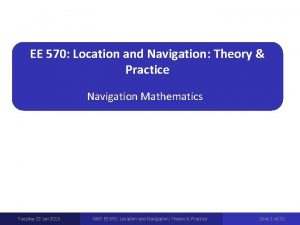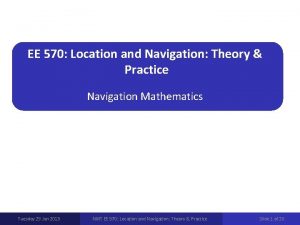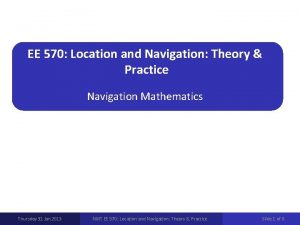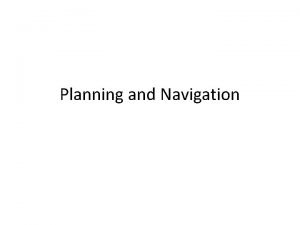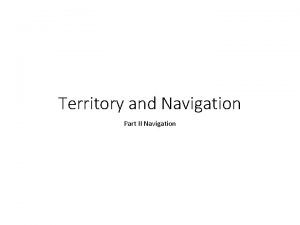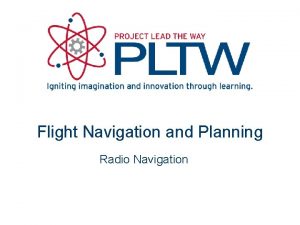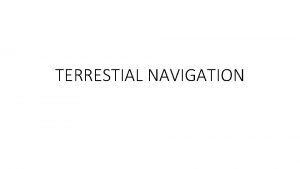EE 570 Location and Navigation Theory Practice Tuesday

















- Slides: 17

EE 570: Location and Navigation: Theory & Practice Tuesday 15 Jan 2013 NMT EE 570: Location and Navigation: Theory & Practice Slide 1 of 17

Course Outline • Required Textbook: § Principles of GNSS, Inertial, and Multisensor Integrated Navigation Systems, by Paul Groves, Artech House, 2008. • Recommended Software: § MATLAB Student Version • Lectures: § Tue/Thur 11 am - 12: 15 pm in CRAMER 123 • Instructors: § Dr. Stephen Bruder § Prof. Aly El-Osery Tuesday 15 Jan 2013 NMT EE 570: Location and Navigation: Theory & Practice Slide 2 of 17

Course Outline • Course Description § This course will cover the basics of terrestrial location and navigation with an emphasis on practical exposure to the technology. In particular, the class will collaborate on the design, integration, and testing of a UGV or UAV. Tuesday 15 Jan 2013 NMT EE 570: Location and Navigation: Theory & Practice Slide 3 of 17

Course Outline • Course Description § Key components of the course include: o o o o GPS fundamentals; an overview of inertial navigation technology; principles of strapdown inertial navigation systems including coordinate frames, attitude representation, and mechanization in various coordinate frames; sensor technology covering a wide range of accelerometers and gyroscopes; sensor specifications and characterization; testing and calibration approaches; effects of inertial sensor error and compensation methods; and introduction to unmanned systems; analysis of real sensor data and simulation and modeling using MATLAB/Simulink. Tuesday 15 Jan 2013 NMT EE 570: Location and Navigation: Theory & Practice Slide 4 of 17

Course Outline • Grading Scheme § § Homework Assignments: 30% Three mini-projects: 10% each Final Project and report: 30% Class Participation: 10% Tuesday 15 Jan 2013 NMT EE 570: Location and Navigation: Theory & Practice Slide 5 of 17

Course Outline • Navigation Mathematics (Dr. Bruder) § § § Introduction to Navigation Coordinate frames Kinematics Earth surface and Gravity Frame Transformations Tuesday 15 Jan 2013 Part II: Chapter 2 of the textbook NMT EE 570: Location and Navigation: Theory & Practice Slide 6 of 17

Course Outline • Navigation Sensors and INS Mechanization (Dr. Bruder / Prof. El-Osery) § § Accelerometers Gyroscopes Error Characteristics Inertial Navigation Equations Tuesday 15 Jan 2013 Part III: Chapters 4 & 5 of the textbook NMT EE 570: Location and Navigation: Theory & Practice Slide 7 of 17

Course Outline • INS/GPS Integration (Prof. El-Osery) § § § GPS Kalman Filtering Integration Architectures System Model Measurement Model Part III: Chapter 6 Part II: Chapter 3 Part IV: Chapter 12 • System Example (All) Tuesday 15 Jan 2013 NMT EE 570: Location and Navigation: Theory & Practice Slide 8 of 17

EE 570: Location and Navigation: Theory & Practice Introduction to Navigation Tuesday 15 Jan 2013 NMT EE 570: Location and Navigation: Theory & Practice Slide 9 of 17

Introduction to Navigation: What is Location and/or Navigation? • What is Navigation? § The process of determining a vehicle’s “course” by geometry, astronomy, radio signals, or other means o Often described by Position, Velocity, and Attitude (PVA) § This can be accomplished via “position fixing” or “dead reckoning” o o Position Fixing - Directly measuring location Dead Reckoning - Measures changes in position and/or attitude – Need to be initialized and then “integrate” the ’s – Inertial sensors measure the ’s without requiring an external reference Tuesday 15 Jan 2013 NMT EE 570: Location and Navigation: Theory & Practice Slide 10 of 17

Introduction to Navigation: A Simple Example of Dead Reckoning • A Dead Reckoning Example: § At each epoc we measure x and y with noise ( =1 m) § Then add to the prior location Tuesday 15 Jan 2013 NMT EE 570: Location and Navigation: Theory & Practice Slide 11 of 17

Introduction to Navigation: A Simple Example of Dead Reckoning • A Dead Reckoning Example 1, 000 Monte Carlo Runs § Radial error at each update (in m): o 1. 49, 1. 97, =3. 68 =3. 42 =3. 94 2. 46, =3. 16 2. 83, 3. 16, =2. 83 =4. 18 3. 42, 3. 68, =2. 46 3. 94, 4. 18 =1. 79 r r r r r=1. 49 Tuesday 15 Jan 2013 NMT EE 570: Location and Navigation: Theory & Practice Slide 12 of 17

Introduction to Navigation: Navigation Examples • DARPA Grand Challenge § PVA needed in terms of a local datum o Local coordinate system Tuesday 15 Jan 2013 NMT EE 570: Location and Navigation: Theory & Practice Slide 13 of 17

Introduction to Navigation: Navigation Examples • Aircraft or UAV § Location relative to the earth o Earth Centered Earth Fixed coord. Sys. Tuesday 15 Jan 2013 NMT EE 570: Location and Navigation: Theory & Practice Slide 14 of 17

Introduction to Navigation: Navigation Examples • Spacecraft § Relative to inertial or space coords o Earth Centered Inertial coordinate system Tuesday 15 Jan 2013 NMT EE 570: Location and Navigation: Theory & Practice Slide 15 of 17

Introduction to Navigation: Navigation Concepts • There exists a wide variety of information sources (i. e. sensors) § Inertial, Doppler, GPS, radar, compass, cameras, odometry, barometric, … • How should I describe my location? § Position, velocity, and attitude? o Orientation can get a bit tricky!! • When answering the question of “Where am I? ” the wrt must be very clearly defined!!! § Lead in to the notion of coordinate systems Tuesday 15 Jan 2013 NMT EE 570: Location and Navigation: Theory & Practice Slide 16 of 17

Introduction to Navigation: Navigation Sensors/Instruments • Navigation Sensors: Past, Current, and Future Star Tracker Sextant MEMS Inertial Sensors Lat/Lon Compass GPS Re ceiver Tuesday 15 Jan 2013 NMT EE 570: Location and Navigation: Theory & Practice Slide 17 of 17
 Emadox
Emadox Ps 584
Ps 584 Pep 570
Pep 570 What century is 570 ce
What century is 570 ce Bosch kts 570
Bosch kts 570 Toeic 570
Toeic 570 Canadian auditing standards
Canadian auditing standards 570 - 496
570 - 496 Nia 570 negocio en marcha
Nia 570 negocio en marcha Power 570
Power 570 Purdue computational science and engineering
Purdue computational science and engineering Vigorap 903設定
Vigorap 903設定 A cross country skier moves from location a
A cross country skier moves from location a In location planning environmental regulations
In location planning environmental regulations Tuesday morning praise
Tuesday morning praise On monday and tuesday
On monday and tuesday Practice assessor and practice supervisor
Practice assessor and practice supervisor Software testing and quality assurance: theory and practice
Software testing and quality assurance: theory and practice
